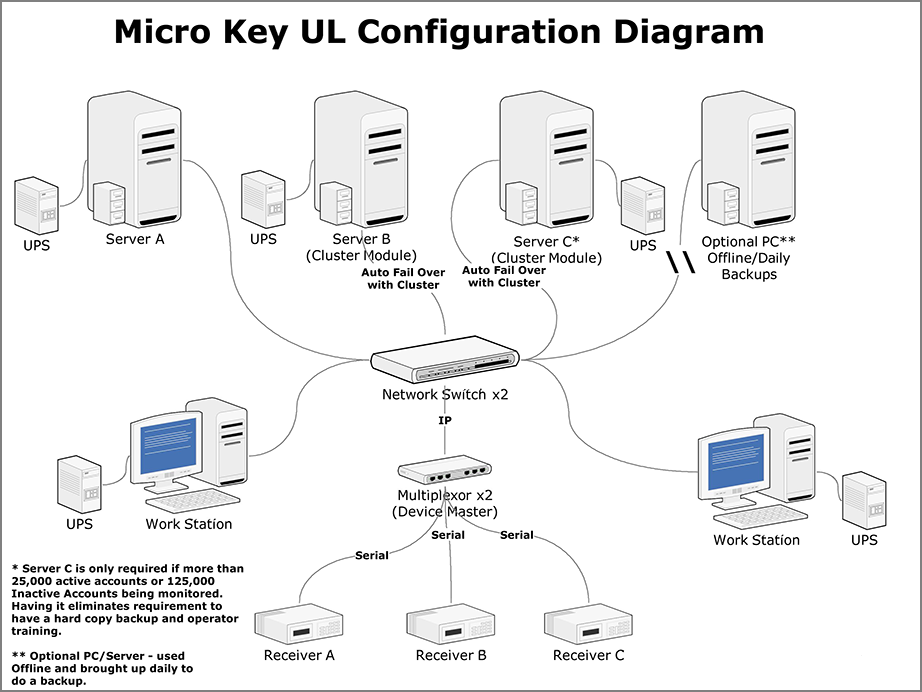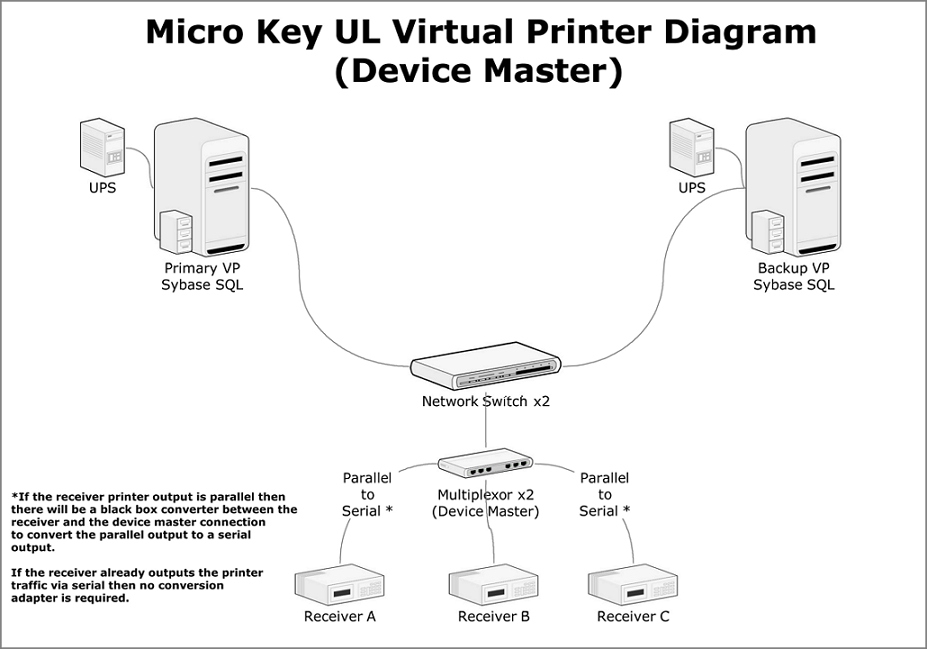❑UL® Listed System Installation & Configuration Diagram - (reference Item 7.1 - Redundancy Requirement in the Third Edition UL® 1981 Standard)

Micro Key UL Configuration Diagram
❑Below is a list of special Third Edition UL® 1981 Standard installation and operational requirements which are to be implemented:
•All the network equipment through which signals pass is redundant - (reference Item 7.1 - Redundancy Requirement Third Edition UL® 1981 Standard)
•7.1 - Redundancy Requirement
✓7.1.1 - The primary system (reference Third Edition UL® 1981 Standard Section 9 - Equipment) shall be capable of supporting a "hot back-up" redundant system, that shall be capable of being on-line, monitoring signals, within 90 seconds.
▪This may take the form of:
a)Another "hot" computer system [see (a) UL Installation Requirements, (b) MKS Systems Status, and (c) MKS Cluster], and (d) Watch-dog Timer; or
b)A fault tolerant system computer system; or
c)a computer cluster.
•7.2 Watch-dog Timer
7.2.1 - If supported by manufacturer, there shall be a watch-dog timer (Watch-dog Timer) to provide supervision that the automation system(s) are operating as intended.
▪Should one of the automation systems become unable to process signals, an audible and visual signal shall be annunciated.
▪Exception: A watchdog timer is not required if the automation system meets the following:
•The automation system monitors the operation of all active computers and receivers (MKS Systems Status, MKS Cluster], and Watch-dog Timer)
a)The automation system is capable of generating an audible and visual signal within 90 seconds of the occurrence of the fault; or
b)A visual display condition under the failure or switchover condition is obvious to the operator may be used in lieu of both a visual and audible signal.
•9 - Equipment
9.2 - Computer system shall be designated, by the manufacturer with the following minimum specifications:
a)Designed for continuous use, 24 hours per day, 7 days per week;
b)Be specified by the manufacturer as a "high-availability" system;
c)Have no less than two cooling fans;
d)Have no less than two power supplies, each of which can supply power for the entire system;
e)Have no less than two network connections, each of which can service all the system's needs.
•Backup Computers - (reference Item 5.25 - Hot Back-up Third Edition UL® 1981 Standard)
✓A continuously energized computer system that is a back-up to the primary system computer and disk drive [see (a) MKS Systems Status, and (b) MKS Cluster].
•Backup Database - (reference Item 5.43 - Redundant Computer System Third Edition UL® 1981 Standard) also see MKS System Status Application and MKS Cluster
▪Two or more computer systems maintained at a central-station, either of which can quickly be connected and operational for processing signals in the event that the other computer fails to operate.
▪A fault tolerant computer system is considered to be redundant.
•Manual Records storage - (reference Item 16.3 Third Edition UL® 1981 Standard) - Whether the automation system is a non-redundant or redundant system, all of the following records shall be maintained and readily available at the central-station (Subscriber Information Forms).
a)Dispatch Instructions;
b)Arming and disarming, (opening and closing) schedules;
c)Pass card data;
d)Holiday observed schedules, and the time and date that the data file was created;
e)Meet the requirements specified in the Records sections (fire alarm, and burglar alarm) in the Standard for Central-Station Alarm Services, UL 827, as appropriate;
f)A means to permanently record the date and time the action was taken to respond to change-of-status events; and
g)A means to transfer the data from Manually-generated activities into the automation system's permanent record when the automation system is back in normal operation, shall be provided (Manual Signal Entry).
✓Manual records (paper records, microfiche, personal computer storage) shall be kept in the operating area for reference in the event of loss of the automation system. These records shall be updated biweekly.
✓Exception: Central-Stations that use a second back-up computer meeting the requirements of 13.5 are not required to comply with the requirement of 16.3.
•Security Access - (reference Item 6.3, (1)-(7)- Sign-on Security Levels Third Edition UL® 1981 Standard) - The automation system shall have a minimum of five levels (or degrees) of security.
•Alarm (Ticket) Report - (reference items 10.1.3 (a)-(q) Third Edition UL® 1981 Standard) - Upon resolution of any incident resulting in an alarm signal being received, the automation system shall record the following information about all accounts which shall include the following items, as applicable:
✓Upon resolution of a fire, hold-up, or burglar alarm incident, the automation system shall automatically generate an alarm report for certificated Accounts and record it on non-volatile memory.
✓The system shall be capable of generating an alarm report upon demand for non-certificated alarm systems.
✓This report shall include the following items, as applicable:
a)The name and address of the subscriber (fire/burglar);
b)The type of alarm (burglary, hold-up, fire);
c)The designated response time (burglar);
d)Whether there is standard or encrypted line security. When provided, it shall be indicated;
e)The time the alarm was received by the automation system (fire/burglar);
f)The time the police / fire department was notified, and the police / fire department identification number (fire/burglar);
g)The time the alarm investigator No. 1 was dispatched, and the investigator's name and employee ID (burglar);
h)The time the alarm investigator No. 2 (if any) was dispatched, and the investigator's name and employee ID (burglar);
i)The time the alarm investigator No. 1 arrived (fire / burglar);
j)The time the alarm investigator No.2 arrived (if dispatched) (fire / burglar);
k)The elapsed time between the receipt of the alarm signal at the central-station automation system and the investigator's arrival at the protected premises;
l)The method used to verify the alarm investigator's arrival such as radio, telephone, or other means (fire / burglar);
m)Whether the central-station holds keys;
n)Whether the keys were used or not used (fire / burglar);
o)The time the subscriber was notified, the name of the notified subscriber (2 or 3 lines might be required for multiple notifications) (burglar / fire);
p)The disposition of the alarm (fire / burglar); and
q)Whether a sounding device is provided on the alarm system (optional).
➢Note:See the UL® Signal Processing Procedures chapter for more information relating to these 10.1.3 (a)-(q) in the Third Edition UL® 1981 Standard items.
❑The Virtual Printer application provides a phantom printer connection to store Receiver Printer Output in a computer file.
•The Virtual Printer application was designed to help Central Stations reduce the amount of paper it uses over the course of time.
✓Signal traffic from Accounts out in the field is very important and is usually preserved by having the information printed as it comes in from the receiving equipment.
✓This recording process can cost the central station hundreds of dollars in paper and ink costs each month.
•The Virtual Printer application allows the signal traffic that would normally be printed out on plain paper, to be captured and saved to a computer database and stored on a hard drive.
•The Virtual Printer application also allows the end user to review any data received by the receiver for any time period and print it out if so desired.

Micro Key UL$ Virtual Printer Diagram installation utilizing a Device Master